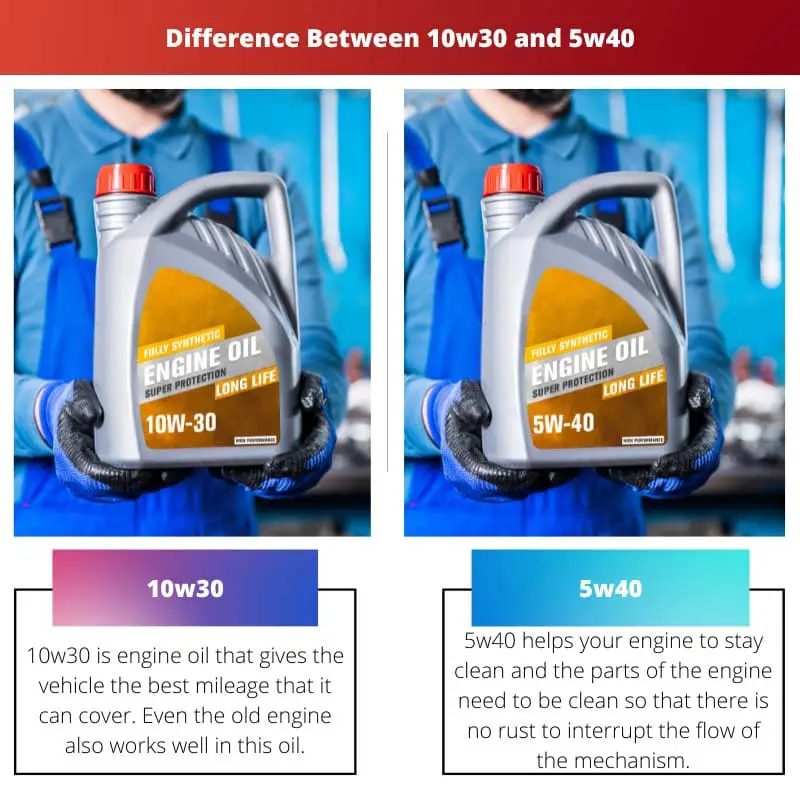We use vehicles to move from one place to another. This helps us to get to a place faster than we can, and to move out of this vehicle we need oil to run it.
This oil varies from different ranges,; different oil types help move the vehicle and keep it in good condition.
Key Takeaways
- 10W30 is a multi-grade oil with a viscosity rating of 10 when cold and 30 when hot, providing sufficient lubrication for various temperatures.
- 5W40 has a lower cold viscosity rating (5) and a higher hot viscosity rating (40), offering better cold-start performance and high-temperature protection.
- Choose 5W40 for improved performance in extreme temperatures and 10W30 for balanced protection across various conditions.
10w30 vs 5w40
10W30 is better suited for use in moderate climates. 5W40 is better suited for colder climates or high-performance engines that need extra protection at high temperatures .5W40 has a lower viscosity rating at low temperatures. 10W3 has a higher viscosity rating at high temperatures.

Every person, buying a new car or another vehicle, always looks for good mileage. If a person is selling his car, the buyer looks and buys it after looking at its mileage.
10w30 is engine oil that gives the vehicle the best mileage it can cover. Even the old engine also works well in this oil.
The engine does not only need to give you good mileage, but also it should keep itself clean and work properly.
5w40 helps your engine to stay clean, and the parts of the engine need to be clean so that there is no rust to interrupt the flow of the mechanism.
The mechanism of the vehicle needs to be good so that the vehicle’s performance doesn’t get worse.
Comparison Table
| Parameters of Comparison | 10w30 | 5w40 |
|---|---|---|
| Characteristics | thicker oil which makes the engine perform well and lubricates a little | lubricates all the parts and makes the vehicle function properly |
| Applications | drivers use this oil if they have a high mileage vehicle | mechanics use this oil to support the high mileage vehicle |
| Type | the oil has a full synthetic formula | drivers use this oil if they have a high-mileage vehicle |
| Suitable Vehicles | this oil is most useful for truck engines or SUV | this oil is used in modern vehicles such as SUVs, light trucks, and passenger cars |
| Capacity | The friction properties of this oil are very good and impressive | The consumption of this oil is very low |
What is 10w30?
‘Winter-grade viscosity is represented by the numerals before the”W.’ In frigid temperatures, the lower this value is, the healthier your motor oil will function. ‘Winter-grade viscosity is represented by the numerals before the ‘W.’ In frigid temperatures, the lower this value is, the healthier your motor oil will function.
The digits after it indicates the viscosity of the oil at extreme temps.
The higher these numbers are, the better they will withstand a higher working temperature. At 0°C (32°F), 10W-30 engine oils behave like such an SAE 10W grade oil, whereas at 100°C (212°F), it behaves like an SAE 30 oil.
10W-30 oil can withstand temperatures as low as -13 degrees Fahrenheit and as warm as 86 degrees Fahrenheit.
As a result, 10W-30 oil remains relatively stable at greater temperatures and pressures, and it can pass through important engine components without producing excessive friction.
Nevertheless, it is a heavier oil with a consistency comparable to grease. As a result, it may not operate as effectively in severely cold areas and at lower temperatures.
Sometimes, a thinner oil, such as 0W-20 or 5W-30, may be preferable. Let’s look at how 10W-30 multi-grade fuel is being used; 10w-30 does have a high capacity to handle high heat without sacrificing engine power quality.
In hotter areas, it can also perform well in elevated temperatures and low settings, adhering to the engine without drying out. 10W-30 has a high capacity to handle higher temperatures without sacrificing engine power quality.
In hotter areas, it can also perform well in pressurized settings, adhering to the motor before drying out.

What is 5w40?
5w40 is a radiator fluid that keeps the motor going smoothly and prevents friction from overheating the mechanical parts. 5w40 helps keep the motor fresh by burning
by-products and prevents corrosion by transferring heat from the reciprocating engine. The external or inner temperatures of the running engine influence the motor oil’s performance.
The number before W determines the mass or fluidity of motor oil.
The greater the rate, the heavier the flow in the engine will be. The letter W stands for cold or wintertime.
The viscosity of 5w40 is five, and the thickness of 40. This oil may be used in lead-based and lightened petrol cars. 5w40 oil has an optimum velocity of 12.5 to 16.3 mm2/s.
The volatility of 5w40 fuel oil in the winter is 5, which indicates it is less sticky at shallow temperatures.
The highest viscosity rating is 40, which indicates that it is only vicious when heated to high heat. Europeans mostly use the oil with gas cars and by Americans to fuel big trucks.
Diesel motor oil 5W-40 5L is the finest oil for preventing deposits and protecting the engine over time. The oil layer has been strengthened.
It satisfies the engine’s most stringent requirements. Its synthetic technology meets the most exacting specifications.

The Main Differences Between 10w30 and 5w40
- The main difference between 10w30 and 5w40 oil is that the 5w40 has the best reliability compared to the 10w30 oil. The oil gives the best performance, providing all the engine parts with the best quality of smoothness. As 10w30 does not give such smoothness other than mileage.
- Another difference is the ability to start the engine even in extremely cold conditions. So, the 5w40 oil gives the best performance for the engine to start in an extremely cold climate, and 10w30 gives a rough start to the engine.
- 10w30 gives the vehicle the best mileage, but it needs to be changed after a time. 10w30 lubricates the engine a little, but 5w40 lubricates the engine and other parts smoothly. It keeps the engine clean and makes it able to work for a lifetime.
- The other important difference is that 5w40 is more supportive of the environment than 10w30 oil. The engine should all be supportive towards the environment and not pollute the air. 5w40 is more eco-friendly than 10w30.
- 5w40 provides the best for the vehicle as it need not be changed for the time being, as 10w30 should be changed per the mechanics’ reconditions. 5w40 provides the best quality of oil which lasts for a long period which keeps the vehicle healthy.


The article raised critical points regarding the lubrication and maintenance of vehicle engines. The oil comparison was thorough, offering a well-rounded understanding of the subject matter.
The article has provided an in-depth understanding of 10w30 and 5w40 oil types. The detailed explanations and comparisons have made it easier to comprehend the importance of each type in engine lubrication and performance.
The post’s content was not engaging at all. The article presented mundane information that fails to captivate the readers.
The content of the article has been very informative. The comparisons were detailed and easy to understand. In the future, it would be interesting to address the environmental impact of the oil types discussed.
I second this. A future analysis of the environmental impact could add significant value to the article.
The comparison between the two oil types was detailed, providing comprehensive insights into how each type operates in different temperature conditions. The facts and figures presented were integral in understanding the characteristics of 10w30 and 5w40 oils.
The discussion on the oil types was enlightening. The detailed breakdown of 10w30 and 5w40 was particularly useful, showcasing the benefits of each type in different scenarios.
Indeed, I’ve gained a better understanding of which oil type is suitable for varying conditions and engine requirements.